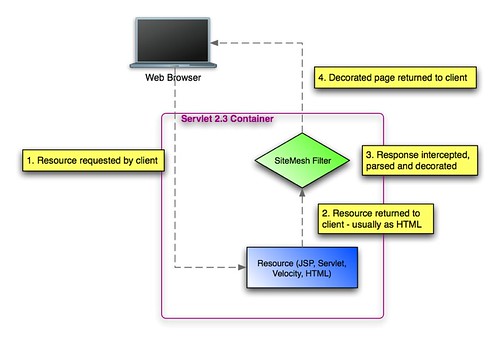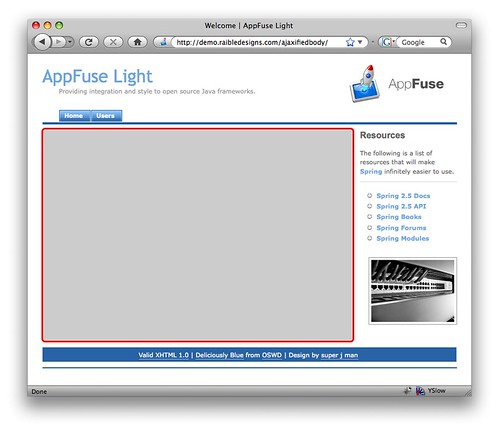 Web Directions is held in Australia and Japan and now the US. A few months ago, they were a bit hesitant about doing it in Denver in the middle of winter. However, they've discovered our best-kept secret: it's beautiful and sunny all week. People are attending this conference from all around the world.
Web Directions is held in Australia and Japan and now the US. A few months ago, they were a bit hesitant about doing it in Denver in the middle of winter. However, they've discovered our best-kept secret: it's beautiful and sunny all week. People are attending this conference from all around the world.
Dan Connolly is the keynote speaker. He's played some very important roles, such as Chairmain of the HTML Working Group during HTML 4. He's also a research scientist at the Computer Science and Artificial Intelligence Laboratory at MIT and a member of the technical staff at the W3C.
Dan's talk is titled Changes in the Languages of the Web and you can view it online at http://www.w3.org/2009/Talks/02wdn/slides.
Web Languages are like languages of the world. Like programming languages, web languages are artificial. Web-native languages are PHP and JavaScript. A Web Language is influenced by natural languages but are artificial. Learning languages is like reading music. With music, most learn from good ol' fashion sheet music. Nowadays, many are learning to read music from Rock Band (the game).
Is there a web language for music? It's not mp3/ogg and it's not Apple's GarageBand. ABC music notation is close and fake-book style cords mostly works. The problem is often these sites and specifications disappear because copyright holders come and scare them away.
Technology deployment rides on the practice of sharing media and culture. Open standards preserve freedom to tinker and supports cultural heritage. Lawrence Lessig at OSCON 2002:
- Creativity and innovation always builds on the past.
- The past always tries to control the creativity that builds upon it.
- Free societies enable the future by limiting this power of the past.
- Our is less and less a free society.
Lastly, Lawrence asked what have you done about it?
In 1991, some places would fire you for looking at code from the Net. At the time, Dan worked at Convex, who encouraged participation in Free Software. Convex did business with HP; HP used SGML; HTML was SGML (almost). When Dan read about the World Wide Web from Tim Berners-Lee, he had an excuse to look at HTML as part of his day job.
Computer Science students and hackers learn BNF and parse trees. SGML is a little funny looking, but works mostly like BNF. Feedback loop:
- Draft a DTD
- Run some tests, ask the computer if it matches the test cases
- Discover an issue; repeat
While Dan was at Hal in Austin in 1994, and adding HTML support in products, he:
- Asked other HTML Working Group members to try James Clark's
sgmls parser
- Not many of them were in the habit of building software from source
- Mark Gaither and Dan installed
sgmls as a CGI service
- Feedback loops works over the Web!
Dan was first the editor and then the chair of the standardization of HTML 4. HTML's standardization timeline:
- November 1995: HTML 2.0
- January 1997: HTML 3.2
- December 1997: HTML 4.0
- December 199: HTML 4.0.1
Browser marketplace explodes and then stagnates. Early 1990's - lots of little projects. In 1995, Netscape Navigator IPO rewrites the business books. In the late 90's IE takes over Netscape. After HTML, Dan started working on other stuff: Feb 98 (XML 1.0), Jan 99 (Namespaces in XML), Jan 00 (XHTML 1.0), Feb 04 (RDF and OWL), Apr 06 (SPARQL) and Sep 2007 (GRDDL).
W3C fostered many of the technologies of Ajax and Web 2.0:
- HTML, CSS, DOM, XML from W3C circa 2000
- JavaScript from Netscape, ECMA in 1995
- XMLHttpRequest from Microsoft in 1999
W3C's efforts since then lacked clear deployment paths.
XHTML is not the solution to a problem that concerns anybody except the guys who have to write parsers that convert markup into DOM trees. It turns out that XHTML put the validation on the wrong end of the network. It turned out that the market didn't put much value in a document delivery system that could decide to not display the document because there was an unrecognized attribute on an invisible meta tag.
-- Doug Crockford Jan 2008
The web isn't just for computer geeks anymore. From The Future of Information by Ted Nelson in 1997:
The software world currently corresponds to the Pre-Director stage in movie-making (1893-1904). During those years, when short films were already being shown in theaters, the job of making the movie was given to the cameraman - because he knew how to work the equipment.
That is how it is with software today. Today's software designers are those who only understand the technicalities, and not - with rare exceptions - those who understand how to integrate the presentation of ideas to the mind and heart.
The Web facilitates a shift from mass media to participatory culture. Worth watching: An Anthropological Introduction to YouTube by Michael Wesch and the Digital Ethnography Working Group.
The W3C HTML Working Group charted in March 2007 and ended up with hundreds of participants (most prior working groups had 20-30 people). In November 2007, there was an HTML WG meeting at W3C Technical Plenary and was very much an unconference. The HTML 5 Working draft was published in January 2008. Goals for HTML 5:
- Off-the-shelf parsers and tools for reading web pages like browsers do, including tag soup
- Modern test materials
- Standardize successful experiments in the Web Applications platform to balance the attraction of proprietary approaches:
- <video>, <audio>
- scripting details, security policies
- offline storage
HTML 5 co-chairs: Chris Wilson (Microsoft) and Sam Ruby (IBM) with W3C staff support from Mike Smith and Dan Connolly.
Some ideas from the CSS validator roadmap:
- JavaScript CSS parser
- Support for CSS 2.1 forward-compatible grammar
- Integrate test-result data showing browser support
The browser marketplace is moving again.
How about authors? How do they feel about HTML 5? Two days ago, Dan received support from Adobe to work on HTML 5 materials for authors.
Design Principles Last Through Change. From Zeldman on Twitter: Client who saves $5K buying cut-rate non-semantic HTML will later spend $25K on SEO consultant to compensate.
There's still something to the nothing behind XHTML+CSS Web Design. Kudos to whoever designed the Kansas Tax web site (Dan is from Kansas City).
Sharing data in documents is one of the original goals of the WWW. Dan has been investing some of his own time into microformats.
Tantek Çelik in June 2006: "XML formats in the long run are not better than propriety binary formats."
- XML, both in technology (namespaces...) and as a "technical culture" is too biased towards Tower of Babel outcomes.
- A few XML formats may survive and converge (RSS, maybe Atom).
- But for now, XHTML is the only longterm reliable XML format that has more to do with it being based on HTML than it being XML.
And if longevity is not a goal, try JSON - it's yummy.
Microformats are not just technical ideas, but it's something that you can actually use in your life. XSPF - what if media players had used an XHTML dialect a la hMedia. RSS and hAtom - will feed readers grow native support for hAtom? Will calendar subscription clients grow native support for hCalendar? The process and the technology of microformats provide an 80% solution for global scale problems.
The Personal Information Disaster: The bane of my existence is doing things I know the computer could do for me. -- The XML Revolution, Nature Web Matters Oct 1998.
Let's find ways to make it cost-effective record and share knowledge formally, i.e. so that computers can manipulate it. How great would it be if your kid's soccer coach could distribute a schedule that would feed into everyone's calendaring system?
Flickr, Facebook and Twitter demonstrate the attraction of hosted services. Identi.ca supports federation (OpenMicroBlogging). Instant Messaging is much like e-mail used to be, where you couldn't e-mail folks that used a different provider.
Be careful not to delegate too much to machines!
- A United Airlines near-bankruptcy item from 2002 appeared as 2008 news via Google News
- Syndication continued up to a Bloomberg news flash.
- UAL stock cratered from $12 to $3 ($1.14 billion in market cap).
- The stock recovered within the day to $10 (down $300M in market cap)
Something to keep an eye on - SEC Interactive DATA and XBRL. Three dozen companies, representing more than $1 trillion of market value, have joined the SEC's test group. Have been working on this since 2005.
Conclusion
The balance between proprietary risk/reward and open standards is delicate. Media independence is more important than ever as mobile emerges. When content doesn't match specs, changing browsers is cheap compared to changing all the content, authors. Web technology is deeply intertwingled with social, economic context.
I enjoyed Dan's talk. He's obviously a smart guy and has been involved with the web since before it even existed. More than anything, I like the conference location. It's 1/2 block from my office and has excellent views. I hope to return for The State of the Web 2009 later this afternoon.





